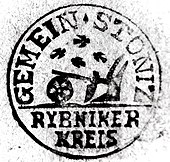Stanica (Pilchowice)
| Stanica Stanitz |
||
|---|---|---|
 Help on coat of arms |
|
|
| Basic data | ||
| State : | Poland | |
| Voivodeship : | Silesia | |
| Powiat : | Gliwicki (Gleiwitz) | |
| Gmina : | Pilchowice (Pilchowitz) | |
| Geographic location : | 50 ° 12 ' N , 18 ° 31' E | |
| Residents : | ||
| Postal code : | 44-145 | |
| Telephone code : | (+48) 32 | |
| License plate : | SGL | |
| Economy and Transport | ||
| Next international airport : | Katowice-Pyrzowice | |
Stanica (German Stanitz ) is a village in Upper Silesia . Administratively it is located in the municipality of Pilchowice (Pilchowitz) in the powiat Gliwicki (district of Gliwice) in the Silesian Voivodeship .
geography
Stanica is 14 kilometers southwest of the district town of Gliwice (Gleiwitz) and 36 kilometers west of the voivodeship capital Katowice .
The former Gleiwitz – Rauden – Ratibor small railway ran through the town .
history
The place originated in the 13th century at the latest and was first mentioned in a document in 1258 in the deed of foundation of the monastery Rauden as "Stanicz" (Stanicia, Stonitz, von Stanie = location, resting place, probably the location of an earlier hunting lodge).
In 1742 the place with most of Silesia came to Prussia. The place was mentioned as Stani (t) z in the book Additions to the Description of Silesia in 1784 , belonged to the Rauden monastery and was in the Ratibor district of the Principality of Ratibor . At that time he had a Vorwerk , a church, a school, two mills, 15 farmers, 22 gardeners and 260 inhabitants. With the reorganization of the administrative structure in Silesia in 1818, the place moved from the district of Ratibor to the district of Rybnik. After secularization , Stanitz came into the possession of the Landgrave of Hesse-Rotenburg and in 1834 by inheritance to the House of Hohenlohe-Waldenburg-Schillingsfürst . In 1865 Stanitz had 177 households and 841 Polish-speaking residents, as well as a ducal farm, a catchy water mill, a branch church and a school building. The Gurniken colony with 20 households and 75 Polish-speaking residents belonged to Stanitz. The school had 284 students at the time.
In the referendum in Upper Silesia on March 20, 1921, 159 eligible voters voted for Upper Silesia to remain with Germany and 417 for membership in Poland. Stanitz remained with the German Reich after the division of Upper Silesia in 1922 . But the majority of the Rybnik district came to Poland, the small part that remained with Germany was distributed to the neighboring districts. On January 1, 1927, the place came to the district of Ratibor. On June 10, 1936, the place was renamed in the course of a wave of renaming of the Nazi era in Standorf . Until 1945 the place was in the district of Ratibor .
In 1945 the previously German town came under Polish administration and was then attached to the Silesian Voivodeship and renamed the Polish Stanica . In 1950 the place came to the Opole Voivodeship . Already in 1952 the place came after a border correction to the Voivodeship Katowice . In 1999 the place came to the re-established Powiat Gliwicki and the new Silesian Voivodeship.
Population development
| 1785 | 260 | |
| 1840 | 693 (14 of them Protestant) | |
| 1901 | 624 | |
| 1913 | 961 | |
| 1941 | 1106 |
Buildings and sights
- The station building of the former Gleiwitz – Rauden – Ratibor small railway.
- Late baroque path chapel from the 19th century.
- Cemetery next to the church mine crosses from the 19th century.
- Residential and farm buildings from the 19th century.
church
The church in Stanitz, consecrated to St. Martin, was first mentioned in 1264, and there is evidence of its own pastor in 1392. It remained the main church until 1812 and then became a branch of Rauden. The classicist church building still preserved today was built between 1801 and 1813 and is Roman Catholic. Church (Parafia św. Marcina Stanica) and belongs to the diocese of Gliwice .
After a storm in December 2017, the cross of the steeple including the tower ball had to be removed for repair. In the tower ball was a "time capsule", which in turn contained numerous documents from the history of Stanitz as well as newspaper clippings and relics .
Web links
Individual evidence
- ^ August Potthast : History of the former Cistercian Abbey Rauden in Upper Silesia. Ceremony for the sixth secular celebration of its foundation. Bauer, Leobschütz 1858, p. 16 and 216 .
- ^ Johann G. Knie: Alphabetical-statistical-topographical overview of the villages, spots, cities and other places of the royal family. prussia. Province of Silesia . Grass, Barth, 1845 ( google.de ).
- ↑ Friedrich Albert Zimmermann: Additions to the Description of Silesia, Volume 3 , Brieg 1784
- ↑ Felix Triest : Topographisches Handbuch von Oberschlesien , Breslau 1865
- ^ Results of the referendum in Upper Silesia of 1921: Literature (Polish, French), table in digital form
- ↑ Information from the community
- ↑ http://www.nowiny.gliwice.pl/sensacja-historyczna-w-stanicy-odkrycie-sprzed-215-lat Nowiny Gliwickie





